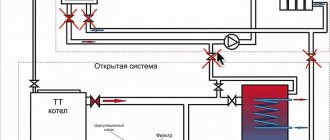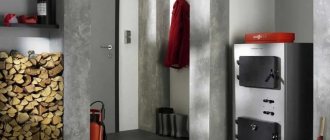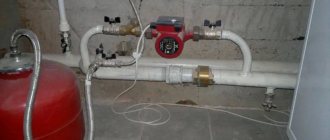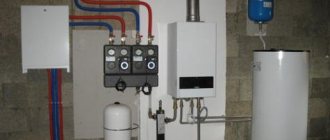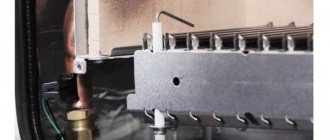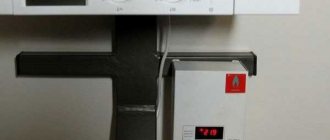Here you will learn:
- Pros and cons of wall-mounted gas boilers
- Types of floor-standing boilers
- Strengths and weaknesses of floor-standing boilers
- Differences between floor-mounted and wall-mounted units
- Comparison using two models as an example
- Which boiler is better for a house or apartment?
- Replacing a floor-standing gas boiler with a wall-mounted one
There are different designs of wall-mounted boilers. They can be divided according to their own characteristics.
By set of functions:
- single-circuit. Designed only for heating the coolant and supplying it to the heating system;
- double-circuit. Capable of simultaneously heating the coolant and preparing hot water for domestic needs.
By type of combustion chamber:
- atmospheric. The traditional design of a gas boiler, in which the combustion process takes place in an open burner with air intake directly from the room. Smoke removal occurs in the usual way, under the influence of stove-type draft;
- turbocharged. The combustion chamber is isolated from the room atmosphere, which ensures cleanliness and the absence of unwanted components. The combustion air supply is provided by a turbocharger fan. Excess pressure arises, which helps remove smoke from the boiler. Typically, such structures use their own horizontal chimney of the coaxial type.
By heat exchanger type:
- separated. The boilers are equipped with either one (primary) unit or two - the primary heats the coolant, and the secondary (plate) indirectly prepares hot water in flow mode;
- combined (bithermic). The design of this unit is close to coaxial types. The coolant flows through one cavity, and water for domestic needs flows through the other. The design is effective, avoids temperature surges, but very quickly becomes covered with a layer of lime deposits that are practically impossible to clean.
According to heat exchanger material:
- steel. Used on inexpensive models;
- copper. Used on products from top manufacturers. Provides high heat transfer and durability.
NOTE! Wall-mounted units have all the capabilities and are produced in all existing structural types. The only type that is not produced in a wall-mounted version is the non-volatile boiler.
Pros and cons of wall-mounted gas boilers
The following advantages can be highlighted for wall-mounted gas boilers:
- Easy to install. A floor-standing boiler with a closed combustion chamber can even be hung in the kitchen. This model does not require a separate boiler room.
- Models with a closed combustion chamber do not require a vertical chimney with natural draft. You can use a short coaxial chimney with penetration directly through the wall.
- Wall-mounted models are cheaper than floor-mounted options from the same manufacturer.
- You can install such a boiler yourself. Connection and launch will be carried out by specialists from the relevant organization.
- You can choose many models with a second circuit, which is designed to produce hot water for domestic hot water.
However, wall-mounted options also have their disadvantages:
- Wall-mounted versions of gas boilers with an open combustion chamber require installation in a separate room - a gas boiler room.
- Boilers with an open combustion chamber require the installation of a full chimney to remove flue gases.
- Wall-mounted boilers do not have cast iron elements and are less durable.
Single-circuit or double-circuit?
Hot water supply is necessary in any home, especially in the cold season. The question is how to obtain this water correctly and most economically. Here everything depends on the maximum consumption in the DHW network, the number of consumers and the simultaneity of their operation. Double-circuit heat generators with a flow-through heat exchanger are relevant when it is necessary to provide 2-3 consumers while turning on no more than 2 taps at the same time.
But what if the consumption and number of consumers is greater? For this purpose, there are heat sources with a built-in or remote storage tank. Then, for a certain period of time, the container will provide a sufficiently large amount of hot water, prepared in advance. The duration of this segment directly depends on the capacity of the tank.
Oddly enough, to supply large quantities of hot water, the use of double-circuit boilers is not required. On the contrary, you should buy and install a powerful single-circuit heat generator and an indirect heating boiler. This scheme is becoming increasingly popular because it allows you to easily obtain the required amount of hot water, although the initial investment in equipment is quite high.
It is impossible to say unequivocally which boiler is better for all occasions; a lot depends on the operating conditions and the wishes of the user. For example, high-tech wall-mounted boilers are more suitable for apartments and small houses, although they can also be used in cottages with several floors. In turn, a stationary unit is a symbol of reliability and good quality, but it is absolutely not suitable for an apartment.
Types of floor-standing boilers
Floor-standing gas boilers are manufactured in all known design options. They can be divided into groups according to different characteristics.
By functionality:
- single-circuit. They are used only for heating the coolant. When connecting an external boiler, they are able to provide the room with hot water at the level of centralized water supply;
- double-circuit. They are capable of preparing hot water for household needs in parallel with heating the coolant.
By heat transfer method:
- convection Conventional heating of liquid in the flame of a gas burner;
- condensation A two-stage heating of the coolant is carried out - first in the condensation chamber from the heat of the exhaust smoke, and then in the usual way. The design has specific conditions for full operation - either a low-temperature circuit (warm floor) is needed, or the difference between external and internal temperatures should not exceed 20°;
- parapet. Units capable of operating in small spaces without a heating circuit. There are holes in the housing that provide circulation of hot air according to the convector principle.
According to heat exchanger material:
- steel. Stainless steel up to 3 mm thick is used;
- copper. As a rule, a coil is installed that has high durability and heat transfer;
- cast iron Used on powerful models that require stable and efficient operation of the unit.
By type of power supply:
- volatile. Boilers, the design of which uses devices that require connection to the network;
- non-volatile. Units capable of operating without being connected to a power supply.
IMPORTANT! Non-volatile boilers are good in conditions of unstable energy supply, or in remote villages.
Operating principle
The operating principle of both types of boilers is the same. The main design elements are a gas burner and a heat exchanger, combined into a single unit.
The coolant enters the heat exchanger, receives a high temperature there and is discharged to the secondary unit. In it, thermal energy is partially spent on preparing hot water. After this, the liquid passes into a three-way valve, mixes in a given proportion with the colder return flow and receives a temperature determined by the current operating mode.
After this, the coolant leaves the boiler and enters the heating circuit, where it makes a circle and returns to the boiler as a return flow. The air is supplied by a turbofan, which also ensures smoke exhaust.
Circulation occurs under the action of a circulation pump. The operation is constantly monitored by a control board and a system of sensors that can detect any problems and immediately notify the owner about them.
Strengths and weaknesses of floor-standing boilers
The main difference between a floor-standing boiler and a wall-mounted one is the absence of restrictions regarding the dimensions and weight of the structure. The combustion chamber has a larger volume, which affects the performance of heating equipment.
Floor-standing models have the following characteristics:
- Floor-standing gas boilers are more reliable - the design uses a heat exchanger made of thick-walled steel or cast iron. The second circuit is made of copper or stainless steel. The service life of a steel boiler reaches 15-20 years, cast iron - 25-30 years.
- Independence from electricity - the practicality of floor-standing boilers lies in the fact that for the most part, stationary models are non-volatile, capable of operating after a power outage.
- Performance – floor-standing versions are available in household, up to 50 kW, semi-industrial and industrial versions. Power limitations are several mW.
The disadvantages of boilers that can be installed on the floor in a room are associated with the following points:
- Large weight of the structure - models with a cast iron heat exchanger weigh several centners.
- Classic type of connected chimney.
- The need for placement in a separate room with a large area.
- Large dimensions and inconvenient floor installation. For the most part, stationary models use an atmospheric combustion chamber, which does not make it possible to hide the boiler in a niche or a special kitchen drawer, which is possible in the case of the wall-mounted version.
It is worth noting that the world leaders in the production of boilers, focusing on the wishes of consumers, are placing increasing emphasis on the production of wall-mounted versions of heating equipment.
What to choose
For clarity, let’s make a table of the features of both types:
| Characteristics and Features | Wall mounted | Floor-standing |
| Functionality | Full set | |
| Durability | Depends on the operating mode. On average, from 10 to 20 years | |
| Power | Up to 50 kW | Up to 500 kW |
| Power supply | Energy-dependent designs | Volatile and non-volatile designs |
| Price | Average | Medium and high |
| Weight, dimensions | Small, medium | Medium, large |
| Difficult to manage and maintain | Average | |
Differences between floor-mounted and wall-mounted units
Let's look at the difference between a floor-standing gas boiler and a wall-mounted one. The principle of operation is the same. The difference lies in dimensions, weight, method of placement and connection. Wall-mounted devices appeared later than floor-mounted ones, but are gradually gaining popularity from them. And there are many reasons for this:
- Mounted models are very convenient to operate; some units with a closed combustion chamber are allowed to be installed in an apartment in a multi-apartment building. While floor-standing boilers can only be placed in private homes or factories.
- Due to their compact size, wall-mounted units with a closed combustion chamber are often installed in the kitchen or bathroom. They easily fit into almost any interior. Most floor-standing gas boilers will require the installation of a specially equipped room - a boiler room.
- Connecting wall-mounted models to all communications is much easier and faster than floor-mounted ones.
- The price of wall-mounted devices is much lower.
Note! The weight of floor-standing units is 3-4 times greater than wall-mounted ones.
Wall mounted gas boilers are suitable for heating rooms up to 120 m². For larger housing, it is better to install a stationary model.
Efficiency and energy consumption
Modern models of floor-standing boilers have an efficiency of 88-90% (models with the old configuration - about 85%). As for wall-mounted ones, the same figure is higher - 90-94%. Accordingly, energy consumption in boilers with lower efficiency is higher, which means that energy costs are also higher.
But you cannot evaluate the efficiency of a model only by the installation method - its efficiency is also influenced by the principle of operation. In the latter case, a distinction is made between conventional and condensing boilers.
Almost all floor-standing boilers are convection - they are cheaper and demonstrate lower efficiency. Although at the same time, due to their simpler internal structure, their repairs are cheaper, and this is a plus.
Wall-mounted boilers are more advanced in terms of design, they have more parts, however, repairs in case of breakdown are more expensive
Wall-mounted - can be either convection or condensation. In the latter, the heat generated from heated gases and combustion products is additionally transferred to the coolant. Thus, the heat does not “fly down the chimney”, but is effectively used. The only inconvenience is that it is necessary to equip a condensate drain from the boiler.
At the same time, floor-standing models can also be condensation, but this is a slow-selling product, since their price exceeds 150 thousand rubles.
Dimensions and weight
Dimensions are one of the most important differences between wall-mounted and floor-standing gas boilers. The dimensions and weight of wall-mounted models are much more modest, otherwise it would simply be impossible to mount them on the wall without the risk of collapse. The lightness of the design is achieved not only by the overall compactness of wall-mounted models, but also by the material from which the heat exchanger is made. For wall-mounted models, the heat exchanger is made only of steel; floor-standing models may have heat exchangers made of cast iron, which is significantly heavier, or steel.
Wall-mounted boilers are often called mini-boiler rooms. And this is no coincidence, because a relatively small-sized housing houses not only the burner, heat exchanger and control system components, but a circulation pump, expansion tank and other elements without which the operation of a conventional boiler room is indispensable. The compactness of the wall-mounted boiler is its main and undeniable advantage. There is no need to allocate a separate room for such a device, because it can be placed anywhere, for example, in the kitchen.
Wall-mounted gas boiler with a coaxial chimney, located in the kitchen.
Floor-standing models inspire confidence with their size. This is exactly what a powerful boiler should be, providing the ability to heat a large building. However, the dimensions of floor-standing boilers often turn into a problem for their owners. Sometimes, in order to bring such a “giant” into a room, you have to dismantle the doorways. There were cases when, due to the impossibility of bringing equipment into the boiler room, the purchased floor-standing gas boiler had to be replaced with two smaller ones.
Floor-standing gas boiler and indirect heating boiler.
Heat exchanger material and service life
This criterion is used to determine the reliability of the device.
Specific models traditionally have their own heat exchangers:
- Floor-standing models use reliable and heavy cast iron. It is good because it is not afraid of corrosion, is durable and has a high density and thickness. This allows boilers with a cast iron heat exchanger to operate without interruption for up to 25 years.
- In suspended boilers, it is replaced with light steel or copper. Steel is a cheaper option, but is thin and therefore prone to warping and rusting. Such models will last, if you're lucky, 12-13 years. Copper is more durable and conducts heat better, but is used only in expensive models.
Please note that the statement that wall-mounted boilers are less reliable due to the complexity of their design is nothing more than a myth.
According to the characteristics declared by the manufacturer, the service life of wall-mounted boilers is somewhat shorter, but this does not mean that in life they often break down and quickly fail. When used carefully, they can last as long as floor-standing boilers.
In fact, durability is affected not by the number of parts and structural elements, but by the material of the heat exchanger.
So, it is in floor-standing models that a cast iron heat exchanger is most often installed, which is considered the most durable material. Therefore, their service life differs from wall-mounted boilers in which heat exchangers of lighter materials are mounted.
Burner and chimney type
Mounted boilers always (even inexpensive ones) have simulated burners installed, while floor-mounted boilers have one- or two-stage ones.
Let's briefly explain what this means:
- Single stage. Those that can only be in the on or off position, and do not imply intermediate modes.
- Two-stage. They can operate at 50% or 100% power control.
- Modulated. The user can at his own discretion select the operating mode from 20% to 100% power.
The “ideal” mode is considered to be one in which fuel is constantly burned at minimum power. More advanced modulating burners allow you to more accurately set the temperature and use gas more economically.
Installation of floor-standing boilers requires the organization of a boiler room. Installation in a hallway or corridor with organized natural ventilation is acceptable. Most wall-mounted gas units are allowed in kitchens
As for the chimney, in 90% of cases with floor-standing boilers it has to be equipped separately. This is explained by the fact that they are equipped with an atmospheric burner and an open combustion chamber, i.e. the air that is taken from the premises must subsequently be “discharged” outside.
In wall-mounted models, the combustion chamber is closed, so air enters and exits through a coaxial chimney. Floor-standing models with a turbine burner also remove gas processing products using a coaxial system.
Installation of models with a two-pipe chimney is simple and less troublesome, but in case of severe frosts (from -15°C and above), condensation will form in it. This can lead to icing and stopping the heating system.
If hot water preparation is necessary, then it is better to supplement a floor-standing gas boiler with a boiler. You can purchase a floor-standing unit that heats both coolant and hot water, but in this case the quality of preparation is reduced
Therefore, based on this criterion, it is impossible to clearly answer which gas boilers are better for you personally - wall-mounted or floor-mounted. As you can see, with a floor-mounted chimney you will have to tinker with the chimney longer, but in the future you can rest assured that its stable operation even in severe frosts.
As for the wall-mounted one, there will be less hassle during the installation process, but more trouble when the thermometer drops below -15°C.
Automation and set of functions
The automation of wall-mounted boilers is more advanced, so they are more convenient, safe and easy to use. For example, they are equipped with a frost prevention mode, protection against overheating, pump blocking, lack of traction, and self-diagnosis.
The process of heating water in mounted boilers is fully automated. Starting and stopping equipment, as well as interrupting work in the event of a dangerous situation occurs without the participation of the owners
Among the functional capabilities of floor modifications, gas control and overheating prevention should be mentioned. Auto-ignition is less common.
Price and range
Wall-mounted structures, even despite their more modern and laconic design, as well as a more complex device, are cheaper than floor-mounted ones.
This can be explained by the fact that the market for mounted models is more competitive, and also by the fact that spare parts for them and maintenance are cheaper. There is more demand for them - naturally, manufacturers offer more options and price differences.
Coolant and its properties
Here, again, the choice will depend on where the heating system will be installed and how often it will be used:
- Floor-standing boilers can operate with any coolant. Antifreeze is also suitable, so if you need to heat a dacha or a house where you do not live permanently, you should choose floor-mounted configurations with antifreeze as a coolant. This way you won’t have to worry about the system freezing or depressurizing.
- Wall-mounted appliances cannot run on antifreeze. The reason lies in the viscosity and fluidity of the substance, as well as its negative impact on the condition of steel or copper heat exchangers, which are used in mounted models.
If you focus on this criterion and decide whether to choose a floor-standing or wall-mounted model of a gas boiler, which unit is more reasonable to prefer, then floor-standing designs definitely win.
Dependence on the power grid
If you want to choose a gas boiler wisely, you should take into account the specifics of electricity supply in your region. The non-volatile model will work even in the event of a power outage. If there are problems, choose floor-standing models. About half of them are energy independent.
The only drawback is the piezo horn, which must be done manually. However, in a situation with unstable energy supplies, you can turn a blind eye to this minus for the sake of stable operation of the boiler.
The advantage of non-volatile floor-standing boilers is that they can be used in regions with unstable power supplies. Since any wall-mounted boiler runs on electricity, problems will arise during interruptions
As for wall-mounted boilers, there are no options: they all require connection to the electrical network, and if you want to make the heating system non-volatile, you will have to additionally install a generator or UPS (uninterruptible power supply), which, of course, will result in additional expenses.
Bottom line
Having information about the general principles of operation of wall-hung and floor-standing appliances, as well as their functional differences, the consumer can decide for himself which gas boiler to choose - floor-standing or wall-mounted. There are no universal situations, because each family has different financial capabilities. After purchasing the equipment, it is important to install it correctly, legally obtaining all the necessary permits. It is not recommended to ignore these conditions, because gas is a fairly dangerous energy carrier.
Comparison using two models as an example
Let's compare similar models of different types of installation from one of the most common manufacturers BAXI:
| Characteristics | BAXI LUNA-3 COMFORT 1.240 Fi (wall convection) | BAXI SLIM 1.230 iN (floor convection) |
| Number of circuits | single-circuit | single-circuit |
| power, kWt | 25 | 22,1 |
| Efficiency, % | 92,9 | 90,2 |
| Combustion chamber type | closed | open |
| Heat exchanger material | copper | cast iron |
| Natural gas consumption, m3/hour | 2.84 (0.1136 m3 per 1 kW) | 2.59 (0.1172 m3 per 1 kW) |
| Dimensions (WxHxD), mm | 450x763x345 | 350x850x600 |
| Weight, kg | 36 | 103 |
| Equipment and functions | circulation pump, expansion tank (8 l), power indicator, thermometer, pressure gauge, auto-ignition, flame modulation, room thermostat, programmer, remote control, external control connection, heated floor connection | power indicator, auto-ignition, flame modulation, external control connection, underfloor heating connection |
| Protection and safety | autodiagnostics, gas control, overheating protection, frost prevention mode, safety valve, air vent, pump blocking protection | autodiagnostics, gas control, overheating protection, frost prevention mode, pump blocking protection |
| Cost, rub. | 49 000 | 61 000 |
The difference between the models is noticeable; moreover, one of the best, most efficient and functional models was taken as a representative of floor-standing gas boilers. Comparing other models, you can notice a much more noticeable difference in gas consumption, the lack of protection against pump blocking and the anti-freezing mode in the floorstands.
Equipment
The factory configuration of a wall-mounted gas boiler, as a rule, includes not only the heating device itself, but also a circulation pump, an expansion tank, control system elements, and all the necessary sensors and valves. Moreover, all this is hidden in the body of the boiler itself.
By purchasing a wall-mounted gas boiler, you get a miniature boiler room for your use, that is, the minimum set that, after connecting to the heating system, is able to begin full-fledged work on heating your home.
Of course, if you wish, you can additionally purchase all kinds of room thermostats and regulators, outside temperature sensors, a GSM communication module and much more, improving the heating system of your home and increasing the comfort of its control.
A floor standing boiler is usually just a boiler. Circulation pumps, an expansion tank and many other related equipment are not included in the delivery package - you will have to purchase everything you need separately.
Wall-mounted gas boiler with lid removed.
Which boiler is better for a house or apartment?
It is difficult to give a universal assessment, since each situation is individual, but basically in practice it happens like this:
- floor structures are purchased for heating the private sector (houses, cottages);
- hanging - for apartments due to their small size and visual appeal.
Although it is important to make a reservation here. In every sense, floor-mounted mini-boiler rooms are definitely more reliable, since they have a more durable heat exchanger, and they are also easy to use even at critically low temperatures outside.
Plus, add energy independence to everything, and then you will understand why many people prefer to install them even in apartments.
Wall-mounted boilers are good because they can be built into kitchen units and take up a minimum of usable space in small urban kitchens
But if you have limited living space and live in a region where severe frosts are very rare, it is more rational to install a wall modification. It will also cost less.
Power modulation
Depending on the implemented method of regulating the flame intensity, all boilers are divided into boilers with a stepped or modulating burner. One- and two-stage burners have one or two operating modes, respectively (usually 100% and 70% of maximum). The power of modulating burners can be smoothly adjusted over a fairly wide range, which allows fine-tuning the operation of the boiler. Modulating burners provide fuel savings and allow you to maintain the set temperature with minimal deviations.
A significant part of floor-standing gas boilers are equipped with one- or two-stage burners. Most wall-mounted models have a wide range of power modulation (from 40 to 100%), due to which they operate “softer” - they turn on and off much less frequently than boilers with stepped burners.
Energy independence
For some consumers, an important parameter of a gas boiler may be the dependence of its operation on electricity. The energy independence of heating equipment is relevant for those whose house or cottage is located at a considerable distance from large populated areas, i.e. in places where power outages or power surges in the network are possible, leading to the failure of expensive automation.
Autonomy of a gas boiler can be achieved in two ways. The first is to simplify the boiler control system as much as possible. That is, it is necessary to use a unit in which there is no electronics at all. All automation of such a boiler is mechanical. A heating system that uses a similar boiler that operates without electricity must have natural circulation.
The second method is to use an electric generator, which converts the heat obtained by burning gas into electricity necessary for the operation of the boiler automation. This option is preferable for most users because it creates fewer restrictions.
You can find energy-independent models only among floor-standing gas boilers, which for some buyers will be a strong argument in favor of the latter.
